The purpose of oral home care is to remove plaque. This matrix accumulates on the tooth surface and more importantly populates the gingival sulcus, where the bacteria in the matrix begin to irritate the gingival tissues. If this plaque and associated bacteria is not removed on a regular basis the irritation results in an inflammatory process and gingivitis is established (Figure 1). Gingivitis in many cases progresses from a mild form to moderate, and then to severe, all of which can be reversed and gingival health restored via tooth brushing. If gingivitis progresses to periodontitis, the destruction of tissues supporting the teeth, no amount of tooth brushing will reverse it and treatment under general anaesthetic will be indicated. It is recommended that at this point readers refer to Bloor‘s (2015) article regarding periodontal probing and charting for further information about the grades of gingivitis and progression to periodontal disease.
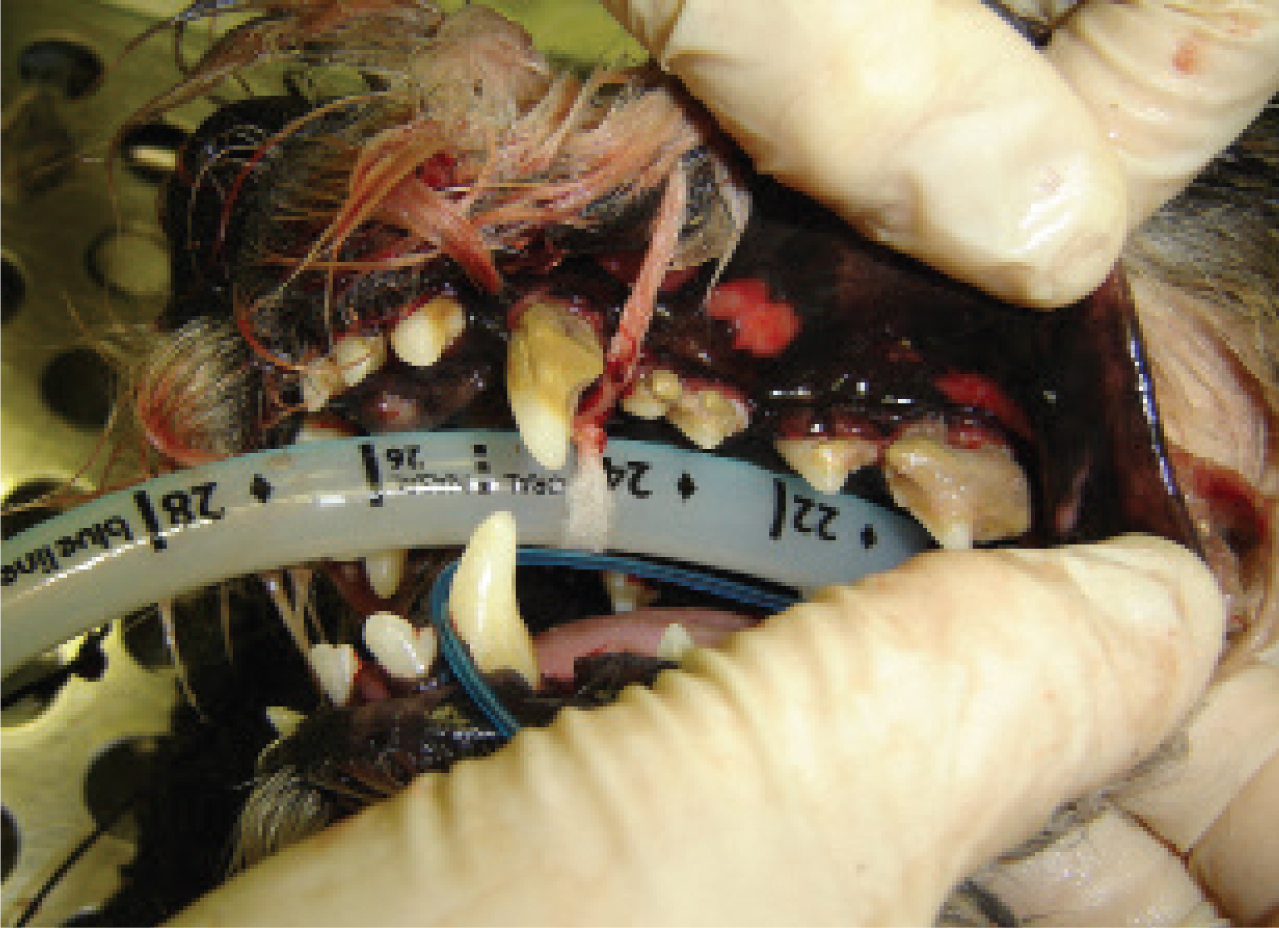
Mechanical removal of plaque from the tooth surface and the gingival sulcus is most effectively done with a tooth brush, as the bristles can sweep subgingivally and remove the plaque. This is the single most effective means to remove plaque (Gorrel, 2011). Dry dental diets (kibbles) and dental chews can serve to mechanically scrape the crowns of teeth, thus removing plaque and calculus from those surfaces, but no kibbles or chews can remove plaque from the gingival sulcus where it is most problematic; the enamel bulge of the crown is there to protect the gingival tissues from trauma, so deflect kibble and chews away from the gingival margin.
Products
There are many products available for pet owners to purchase that claim to have oral health benefits, such as the reduction of plaque and calculus (tartar) accumulation, or to freshen breath. Veterinary professionals and clients alike should be wary about these claims, and consider the research available to support such claims. The main categories of dental products are diet, chews, edible treats, water additives, oral gels, oral sprays, tooth paste, tooth brushes and dental sealants (Holmstrom et al, 2013). Logan (2006) produced a comprehensive article in which she reviewed available research about different oral health care products for animals, discussing the claimed benefits versus the actual clinical benefits discovered in research studies. While the Logan (2006) article was written a while ago it is still relevant today, and therefore this article will now consider some of her key points and findings about the different products available, as mentioned in the American Animal Hospital Association (AAHA) Dental Care Guidelines for Dogs and Cats (Holmstrom et al, 2013), alongside more current literature about these different products.
Diets and chews
Logan (2006) discussed that some manufacturers have created diets and chews, which they have promoted as having oral healthcare benefits, where the kibbles and chews have been coated with polyphosphates. Polyphosphates are thought to bind salivary calcium, which means it is not available to be incorporated into the plaque biofilm so that calculus cannot then form. Logan (2006) highlighted that some studies have shown that this did decrease the calculus accumulation in the sample, however she also discussed that there are other studies that have shown polyphosphate-coated products resulted in no significant difference in calculus accumulation between the test and control groups.
The incorporation of different additives into chew treats to try and improve oral health care has also been tested in research. Gorrel et al (1998) investigated the efficacy of dental hygiene chews in addition to a dry diet, testing normal chews and ones that had 0.2% chlorhexidine added to them. They found that the dogs fed a dry diet and a normal chew had significantly less gingivitis and calculus accumulation after 3 weeks when compared with dogs fed solely on the dry diet. For the dogs eating the chlorhexidine chews, they found no difference in the degree of gingivitis and calculus when compared with the normal chew, but there was significantly less plaque accumulation after 3 weeks. This was a very short trial compared to the lifespan of a dog and the sample size was 11, so a larger scale study spanning a longer time period involving a larger sample size would be beneficial. The authors concluded that the abrasiveness of dental chews is what makes them most effective rather than the addition of chlorhexidine.
A later study by Hennet (2001) explored the effectiveness of enzymatic rawhide chews in the reduction of plaque accumulation. There were two groups of 11 dogs that were all fed the same diet, but one group were additionally given one of these chews twice a day. They were only studied for 7 days, which is a limitation of the study, but in this time Hennet (2001) reported a decrease in the formation of plaque in the group of dogs who had the additional chew.
There are some more recent studies that have tested the efficacy of dental chews. Stookey (2009) assessed the levels of calculus, plaque and gingivitis accumulation in dogs; initially the sample was fed just a dry diet for 4 weeks, and then they had a dry diet plus a dental chew once a day for another 4 weeks. When they had both the dry diet and the dental chew, there was a significant reduction in calculus, plaque and gingivitis. Clarke et al (2011) performed a very similar study over a 70 day period with 16 dogs, assessing halitosis in addition to calculus, plaque and gingivitis. They found the group fed the dental diet and dental chew had a reduction in halitosis, and a significant reduction in gingivitis, plaque and calculus parameters. Finally, Quest (2013) studied 60 dogs over 28 days using the same study design as Clarke et al (2011), and found the group fed the dental diet and dental chew had a significant reduction in plaque, calculus and halitosis parameters, and improved gingival indices.
With regards to diet, Logan et al (2002) performed a 6 month study comparing the efficacy of a standard dry diet versus a specific ‘dental’ dry diet, considering levels of plaque and gingivitis. They found the ‘dental’ diet significantly reduced the levels of plaque and gingivitis when compared with the standard dry diet. Logan (2006) discussed food texture and composition in her review, highlighting that these factors have direct effects on the oral environment in terms of maintaining tissue integrity, altering the metabolism of plaque bacteria, the stimulation of salivary flow, and the cleaning of teeth and oral surfaces via physical contact. She articulated that there are studies that show that specific dental diets, that have specially designed kibble structures to allow the teeth to sink into the kibble rather than the kibble shattering on tooth contact, are beneficial to improving oral health.
Logan (2006) also mentioned a little about natural, or raw diets, which some people purport as being the best type of diet to maintain oral health because it is what animals would be eating in the wild. Pet cats and dogs are not wild animals, they are domesticated. Logan (2006) outlined that in the available studies of wild animals and their oral health there is still evidence of periodontal disease and actually a high rate of tooth fracture, which when combined with the additional nutritional, public health and gastrointestinal tract concerns negates the use of a natural diet for oral health reasons.
Despite the limitations of the studies available regarding the use of dental diets and chews, it is clear that they do have some oral health benefits, especially when chews are used in conjunction with a dry diet. The veterinary professional however, must remember that kibbles and dental chews cannot sweep the plaque bacteria from the gingival sulcus like a toothbrush can, so will never be considered the best way to maintain oral health. Care should also be taken when advising clients to give chews to their pets as they can lead to weight gain if not factored into the animal's overall nutritional intake. The veterinary professional must also consider the animal's ability to chew; some animals forget, or do not know how to chew properly and can swallow these products whole, potentially resulting in a gastrointestinal foreign body.
Dental sealants
Dental sealants have been used for a number of years and serve as a physical barrier, stopping plaque being able to populate the gingival sulcus. Kunkle et al (2005) studied 40 dogs over 8 weeks, assessing plaque, calculus, gingivitis and gingival bleeding levels. They cleaned the dogs' teeth under general anaesthetic and applied the sealant to the gingival margin. The owners then had to reapply the sealant weekly until the end of the study, where they found a statistically significant reduction in all of the aforementioned levels when compared with dogs without the sealant.
Later, Bellows et al (2012) performed a similar study on 31 cats over 56 days, looking at the same levels as the Kunkle et al (2005) study. They found a significant reduction in the plaque levels of the group with the sealant applied, however no significant difference in the calculus, gingivitis or gingival bleeding levels. This may be due to cats typically being more difficult to handle for gel reapplication, however in the study it was applied in the practice by a trained professional.
Finally, Smith and Smithson (2014) studied 20 dogs in a similar manner to Kunkle et al (2005) using a dental wax sealant; they used the sealant on one half of the dogs' mouths (test), and none on the other half (control), and the owners had to reapply it daily. They found that there was no significant difference in the gingivitis or plaque levels between the test and control sides of the mouths, but there was a significant reduction in calculus on the test side. Only eight of the 20 owners managed to reapply the wax every single day of the study, which is a limitation.
While theoretically the application of a physical barrier to plaque entering the sulcus should be effective in improving oral health, it would be beneficial to have more research performed in this area for longer periods of time and on a greater number of animals. This would better assess product efficacy and also better assess the longer term compliance of owners with the use of the products. Seemingly there are some benefits to using sealants, as demonstrated in the aforementioned canine studies, however in cats perhaps this is not the easiest daily intervention for owners to perform.
Water additives
Clarke (2006) performed a study exploring the effects of a drinking water additive on the accumulation of plaque and calculus in cats. This additive was xylitol, which is a five-carbon sugar alcohol that has an antibacterial effect on oral bacteria, an anti-adhesive effect against plaque, and an anti-calculus forming effect. Over the 56 day study, Clarke (2006) determined that the xylitol-based water additive was effective at significantly reducing the plaque and calculus levels in cats.
People rightly have concerns about xylitol-containing products and their use in dogs as it is a known toxin, however these products for oral homecare purposes have very small amounts of xylitol in them, and if used as per the label instructions will cause no harm to dogs. If any veterinary professional is still uncomfortable about the use of such a product then they do not have to recommend it to their clients. There are also non-xylitol containing water additives on the market which have received the Veterinary Oral Health Council's (VOHC) seal of approval for plaque reduction, so veterinary professionals may opt to promote these products instead of the xylitol-containing ones (please see further information regarding the VOHC below).
Chlorhexidine
Chlorhexidine is a cationic bisbiguanide and is effective in reducing plaque accumulation and gingival inflammation (Logan, 2006). One main use for it within the realms of dentistry is as a pre-procedure mouth rinse to reduce the bacterial content of the aerosol produced when using an ultrasonic scaler. Gupta et al (2014) performed a study looking at the effectiveness of 0.2% chlorhexidine, versus a herbal mouthwash, versus water at reducing the bacterial aerosol. They found the chlorhexidine and mouthwash were significantly better than just water alone, and that chlorhexidine was significantly better than the mouthwash, eliminating the majority of oral bacteria that would have otherwise been aerosolised.
The same conclusions have been drawn in earlier studies by Devker et al (2012) and Shetty et al (2013). The benefits of chlorhexidine-based oral gels and rinses are well documented in research and have proven to significantly reduce plaque indices, gingivitis indices and gingival bleeding levels to a greater extent than other chemicals, and chlorhexidine gels and mouth washes/rinses are more effective than toothpastes containing chlorhexidine (Southern et al, 2006; Slot et al, 2010; Van Strydonck et al, 2012). These studies demonstrate the effectiveness of chlorhexidine in reducing oral bacterial numbers, which is obviously beneficial to overall oral health and therefore should be recommended to owners as part of a good oral homecare regimen. However, the veterinary professional must be aware that over time chlorhexidine can stain teeth, which is not aesthetically pleasing in humans or animals, though animals will be less concerned about this than perhaps their owners. The staining can be removed by performing routine scaling and polishing (Zanatta et al, 2010).
Tooth brushing
The most recent animal-based study about the benefits of tooth brushing on oral health is Harvey et al (2015). It is well documented and researched that tooth brushing is the single most effective way to remove plaque (Gorrel, 2011). The Harvey et al (2015) study aimed to assess whether the frequency of tooth brushing had different effects on plaque, calculus and gingivitis levels. They studied dogs that had their teeth brushed either daily, every other day, once a week, every other week, or not at all. All of the dogs were fed a dry kibble diet. As expected, they found that more frequent brushing was most effective at retarding plaque and calculus accumulation, and it also reduced the severity of any pre-existing gingivitis. Additionally, daily or every other day tooth brushing resulted in statistically significant improvements in all of the aforementioned parameters when compared with the weekly, every other week and no tooth brushing groups. This serves to reinforce that daily tooth brushing, or at least multiple times a week, should be recommended for optimal oral health maintenance.
Summary relating to products
Gorrel (2011) discussed the prevention and treatment of periodontal disease, which is the likely outcome if an animal's oral health is not maintained; gingivitis caused by the accumulation of plaque bacteria in many circumstances will progress, resulting in the need for more lengthy treatments under general anaesthetic. Veterinary professionals should be promoting preventative health care to reduce the need for these types of procedures. Gorrel (2011) surmised that tooth brushing is the single most effective method for removing plaque, however in the absence of this intervention the mechanical reduction of plaque via dietary texture and any other anti-plaque (mechanical or chemical) agents is important and should be highly recommended to pet owners.
She did make an important point though that all veterinary professionals must remember when they are assessing the oral cavity and recommending oral homecare regimens to clients — dry dental diets and dental chews when used in animals that already have periodontitis are unlikely to be effective, and in most circumstances are likely to be contraindicated due to the ensuing transient bacteraemia following mastication, and potential oral discomfort. In these circumstances, treatment under general anaesthetic is indicated followed by the instigation of a good oral homecare regimen.
VOHC
The VOHC was established to review evidence relating to the claims companies make regarding the efficacy of their oral healthcare products in their ability to retard plaque and calculus accumulation. The VOHC has a strict protocol that companies have to follow in their clinical trial designs in order to meet the required standards of evidence. Once the clinical trials are complete, the evidence is submitted to the VOHC and a panel of experts review the data and either rejects the claims made or accepts the claims and awards the VOHC seal of approval.
The details regarding their protocols for study design and the process of review are all available online at http://www.vohc.org/, and they also have a list of dog and cat products to which they have awarded the VOHC seal of approval. They specify in the list what the product is, what type of product it is, and whether they have approved the product for the retardation of plaque, calculus or both. It would be wise for veterinary professionals in practice to check this list of approved products regularly, or be aware of the VOHC logo which companies can use on their packaging if their products have been accepted. However, just because a product does not appear on the VOHC list does not mean it does not help to reduce plaque and tartar on teeth, it just means their clinical trial information has not been submitted to the VOHC for consideration to-date.
Oral homecare regimens
It must be reiterated that only effective tooth brushing can remove plaque bacteria from the gingival sulcus, which is where it is most problematic; plaque initiates an inflammatory response, gingivitis, which can progress to periodontitis, the destruction of tissues supporting the teeth.
The oral homecare regimen recommended to a client will depend on the animal, its character and how cooperative it is, but also the client's willingness and competence at performing or providing adequate oral homecare. Table 1 details the options to consider discussing with clients as oral homecare regimens for an animal according to their abilities and circumstances, beginning with optimal or gold-standard protocol as option one where possible.
| Option One | The owner is willing and able to provide the best oral homecare for their animal |
| Option Two | The owner cannot/is unwilling to brush twice a day: |
| Option Three | The owner cannot/is unwilling to brush every day: |
| Option Four | The owner cannot/is unwilling to brush at all: |
| Option Five | The owner cannot/is unwilling to brush or use CHX oral rinse at all: |
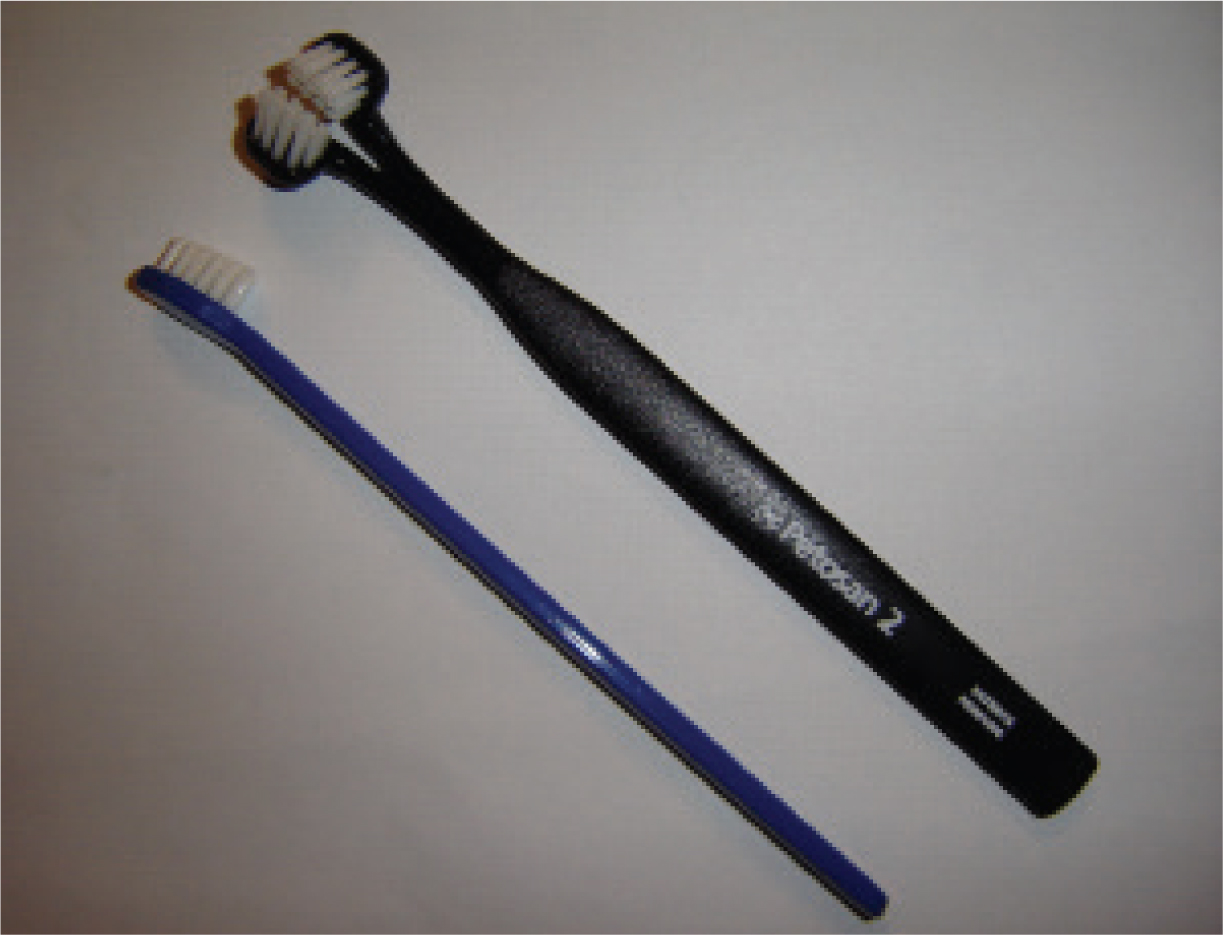
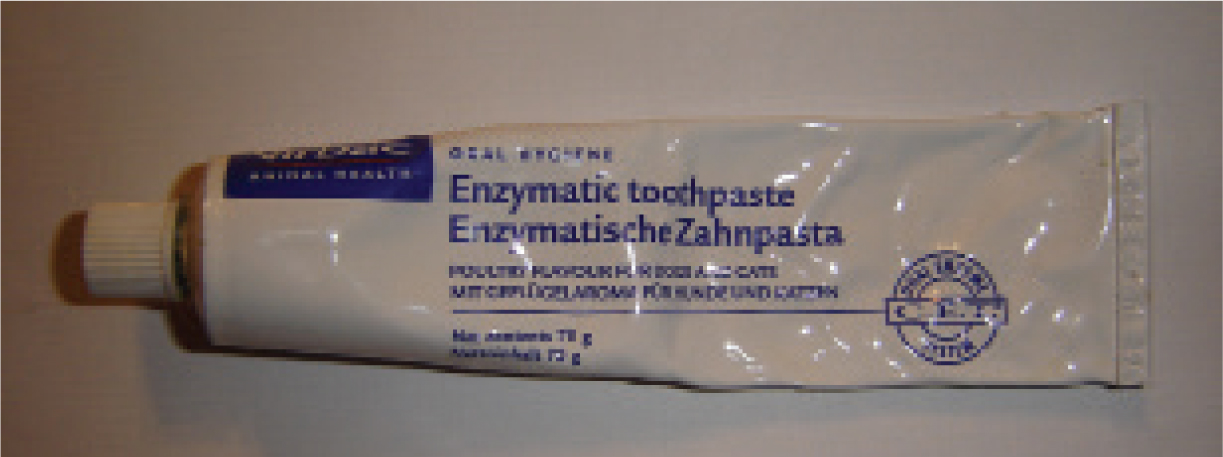
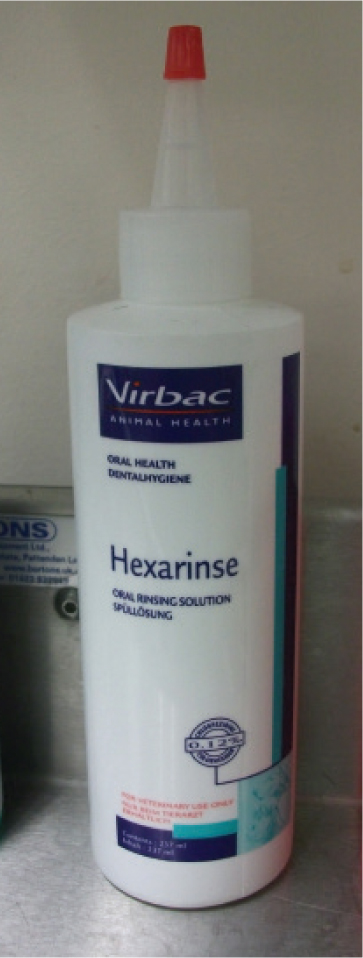
Oral homecare regimens post operatively
When an animal has had dental surgery performed the veterinary professional must tailor the post-operative care for that patient according to the treatment undertaken and decide on an oral homecare regimen that suits both client and patient.
It is advisable, where possible, to ask the owner to trial tooth brushing as part of an oral homecare regimen prior to any dental procedure under general anaesthetic. This enables the veterinary professional to establish the client's capabilities with regards to the provision of home care, which will influence how aggressive the veterinary surgeon (VS) decides to be in their treatment. If an owner demonstrates they are very capable, the VS may decide to salvage some of the teeth rather than extract them, however if the owner is unable to tooth brush effectively the VS is likely to extract more teeth during the procedure as their health and maintenance post procedure will be questionable.
The following protocol is advised with regards to recheck appointments and oral home care:
If the animal has had teeth extracted and the gingivae sutured, tooth brushing immediately in those areas is not advisable. If they have had teeth out on one side of the mouth the owners could start tooth brushing the opposite side until the gingivae are healed. If they do not wish to brush any of the teeth at all until everything is healed, the veterinary professional should advise they use CHX oral rinse post-operatively on a twice daily basis until they are happy to instigate tooth brushing.
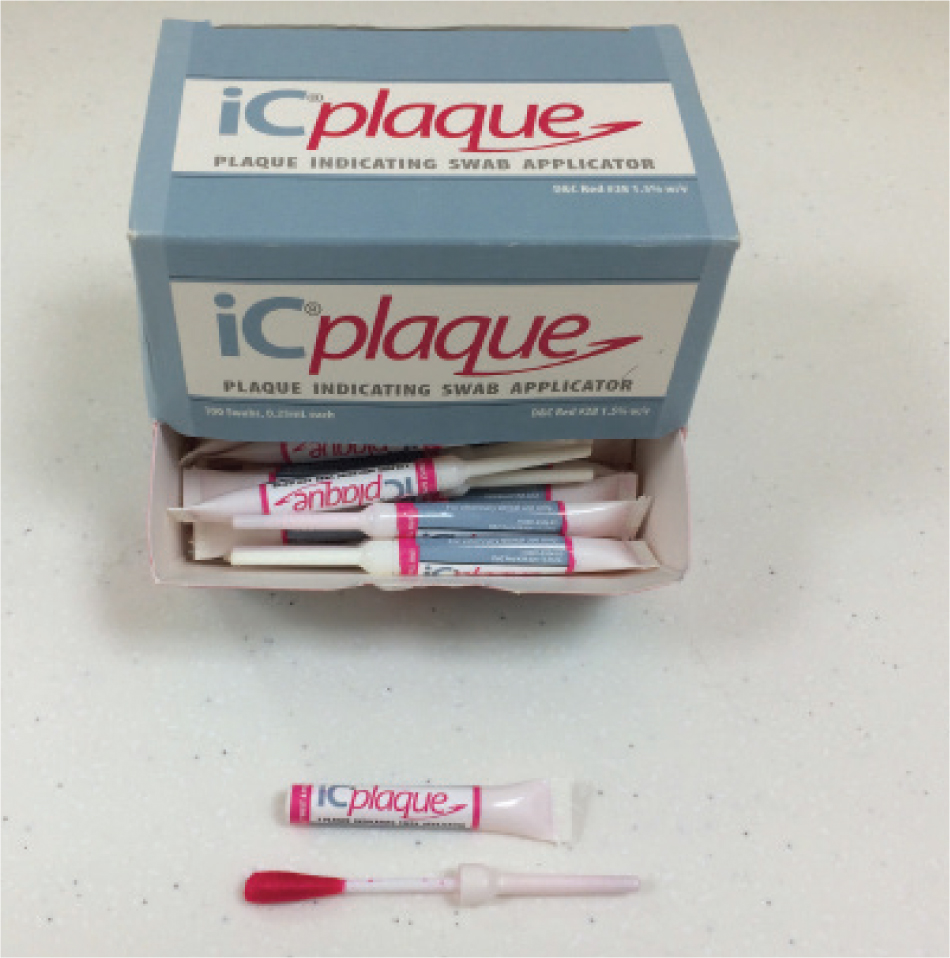
Owner education is key with regards to their compliance with oral homecare regimens, so the veterinary professional should have a variety of resources available, including models, literature, pictures and even videos made by veterinary professionals to help better inform the owners about why oral home care is so important, and how they can successfully implement what is being recommended.
Conclusion
Tooth brushing is the best intervention in the maintenance of optimal oral health and hygiene, using an animal-specific tooth paste to encourage animal compliance. The clients must be taught how to tooth brush properly for maximum benefit. There are numerous products available on the market for the veterinary professional to recommend as adjuncts to tooth brushing, which have been discussed in this article, however the veterinary professional must ensure they are aware of the benefits and limitations of such products. A multi-modal approach to oral home care is recommended, and appropriate assessment of both the animal's and client's willingness to engage with regimens advised is essential to success. Optimal oral health will result in a happier and healthier patient, which should require fewer treatments under general anaesthetic.

